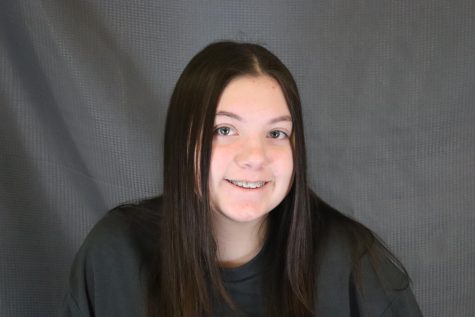The Lingering COVID Impact
College students and educators look back on COVID-19 struggles.
Encountering new regulations, the girls basketball team stayed masked as often as they could. The girls were able to play all of their games this season despite COVID.
May 9, 2022
“It became an open setting; when kids found out that it was optional, I had 33% of kids doing their homework online at first, and then it went down to 10% of kids doing their homework online,” said history teacher Trace Petersen as he reflected on the spring of 2020. When COVID first hit, students thought they would soon be going back to school. They never expected COVID to shut down everything.
Two separate COVID periods affect teachers and students. The first was when there was no in-class learning. The second was when in-class learning resumed with a remote learning option. “The most significant change with no in-class learning was when I could not see my students, and of course, having attendance be voluntary and the challenge of engaging students remotely,” said English teacher Randall Simpson.
The year 2020 was hard, especially for the seniors. They didn’t get the full experience of their final year; it ended without warning. “Obviously the pandemic took away from a lot of exciting things you look forward to while you’re in high school. It was hard to go through all the hard work to miss out on the zoo trip, the senior clap out, and other moments for seniors. I [also] wish we were able to have a real prom and graduation rather than an adjusted one,” said 2020 graduate Katie Saluk.
“I would have to say I did not take COVID as seriously when I was in high school,” said 2020 graduate Kayla Mauk. She said college is where it all changed. “When we continued our education after high school, still all online, I was assigned a lot of group projects. We were supposed to work together without any face-to-face communication.” Now that the pandemic has calmed down, Mauk’s college life is different than she imagined. She said, “For almost every class I have taken, professors start the first 10-15 minutes of class with what they call ‘The Social Interaction Theory’ where students are told to interact and practice socializing with each other. This is because a lot of kids our age missed an entire year or two without the normal social interaction that people have…you could look at it in a positive way, being that I had to figure out a learning style I was not comfortable with, or you could look at it as a negative where I could have been getting better grades and learn at a faster pace if it weren’t for online classes,” she said.
Some college students appreciated the changes brought about by the pandemic. “Iowa State made the transition rather quickly and effectively,” said 2018 AHS graduate Jena Brosam. “Professors made it easiest on us by posting lectures and the entire semester assignments online so we could work at our own pace. It was really nice because I did not have to go on campus, and I did not have to take notes while trying to listen to a lecture. Everything you could possibly need was on the computer.”
One of the biggest changes for teachers, when it came to COVID, was the online aspect of school. Many found it challenging to work with the app “Zoom.” It was a new experience with learning. Some teachers expressed frustration at putting work into online learning, to having only a couple of kids from each grade actually do their assignments.
“I am not sure of the difference between the hardest part and the most challenging. The hardest part is not being able to do what you love. Not teaching and interacting with students,” said Simpson.
Teachers who like a little bit of a challenge thought working online was not a problem. It was making the best of a less-than-ideal situation. Some students missed the structure and accountability of the classroom when their assignments were online. Students have struggled to re-adjust classroom expectations in general.
“I was initially a little nervous about heading back. I was vigilant about wearing my mask, washing and sanitizing my hands, “ Simpson said. A lot of people were not happy about wearing masks and having to stay six feet away from everything. Some tried to disregard the safety precautions.
Most teachers prefer face-to-face learning. It is easier to build relationships and make connections with in-person learning. One thing that a lot of people have noticed is that there is difficulty with learning online. It is more difficult to learn in groups or learn collaboratively. It makes activities like literary groups nearly impossible. In other words, in-person learning gives teachers more opportunities to flex their teaching muscles.










